
Our apartment on Josefgasse was about a five-minute walk away from City Hall and 10 minutes to the Volksgarten and its beautiful roses.
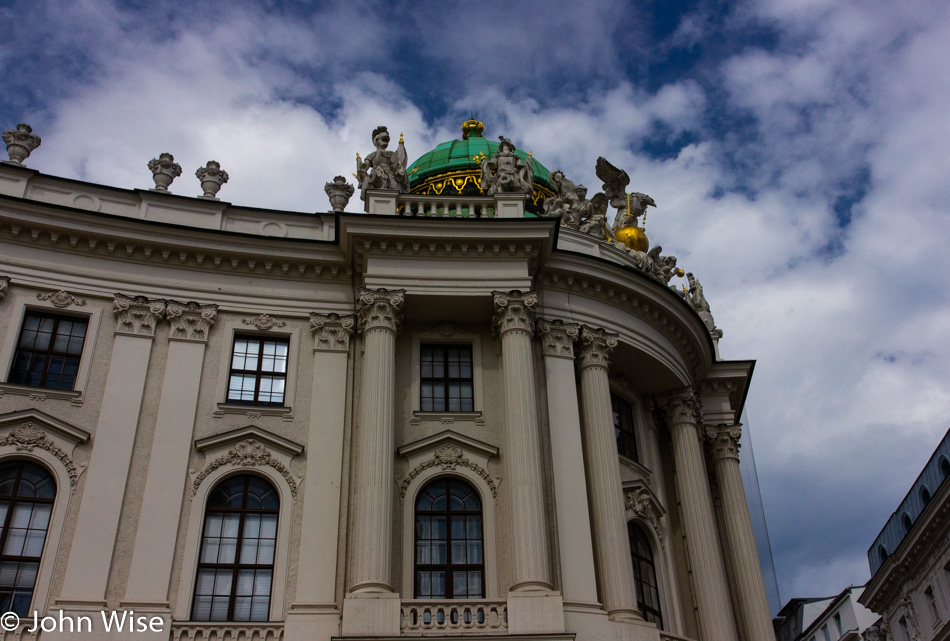
During our stay here in Vienna, I’d estimate we will have walked by one corner or the other of the Hofburg Palace more than a dozen times. While you are here, I dare you not to take a hundred photos of the palace as in every light and time of day; it creates spectacular views that leave you in awe.
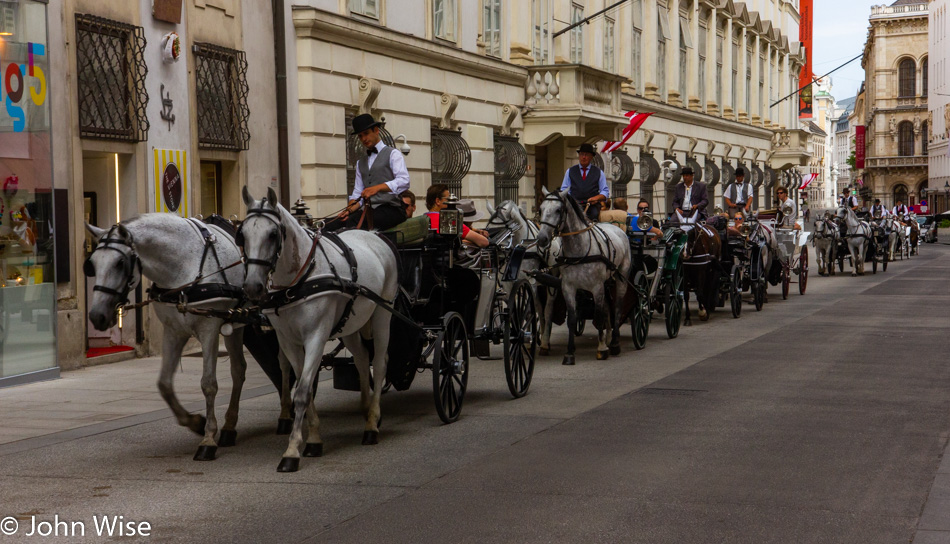
An entire train length of fiaker taking their passengers on a tour of the inner-city of Vienna. Caroline and I eschew these kinds of experiences as they too often feel cliched. While we appreciate that they are still available and that the tradition continues, maybe we’ll change our mind when walking through these areas becomes too difficult, and on one of those visits, we’ll get on board and see if we were wrong the whole time.
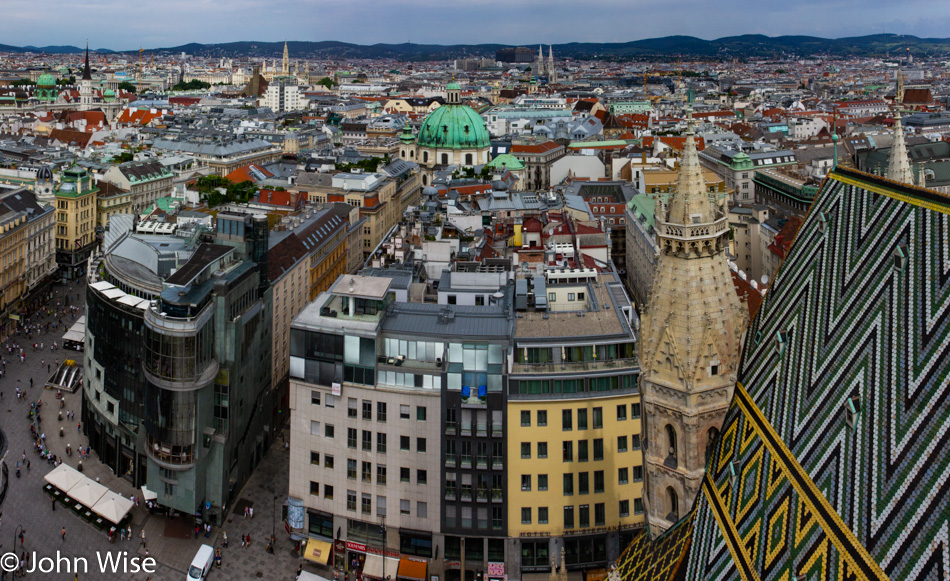
Yesterday, when we stepped into St. Stephen’s Cathedral, it was too late in the day to head up the South Tower. This morning, we wanted to beat the crowds and made it our first stop. The narrow circular stairway climbs 343 stairs to ascend the 67 meters to this view. The hike up is in one of the tightest spaces I’ve gone up, but the view from above is worth the minor effort. My image is skewed due to me only traveling with my 17-55mm lens for the sake of my comfort, which means I had to take nearly a dozen images and stitch them together in Photoshop to achieve this panorama. There’s a wealth of data missing in this low-res version I’m posting, and if I get a couple of requests for a higher-resolution copy, I’ll oblige and post it.
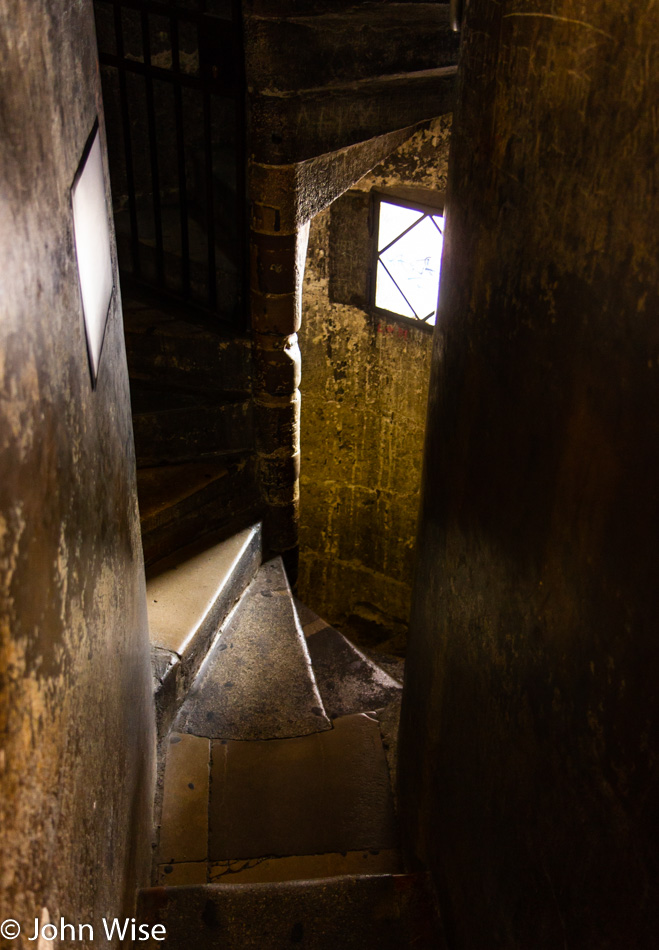
I’m standing in the gift shop to take this photo in one of the rare moments someone wasn’t coming up or going down. With me currently weighing 235 pounds (106 kg), I’d say if you were somewhere closer to 275 lbs, you’d want to think twice about attempting this.
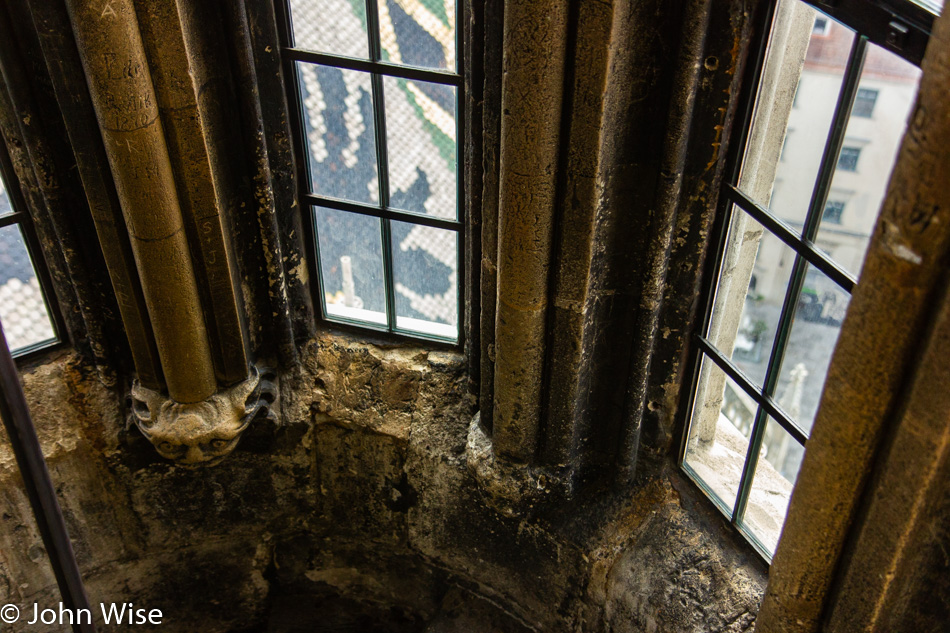
You don’t only find great views while looking out the windows; the texture of this old stone and graffiti from across the ages is also worth taking in.
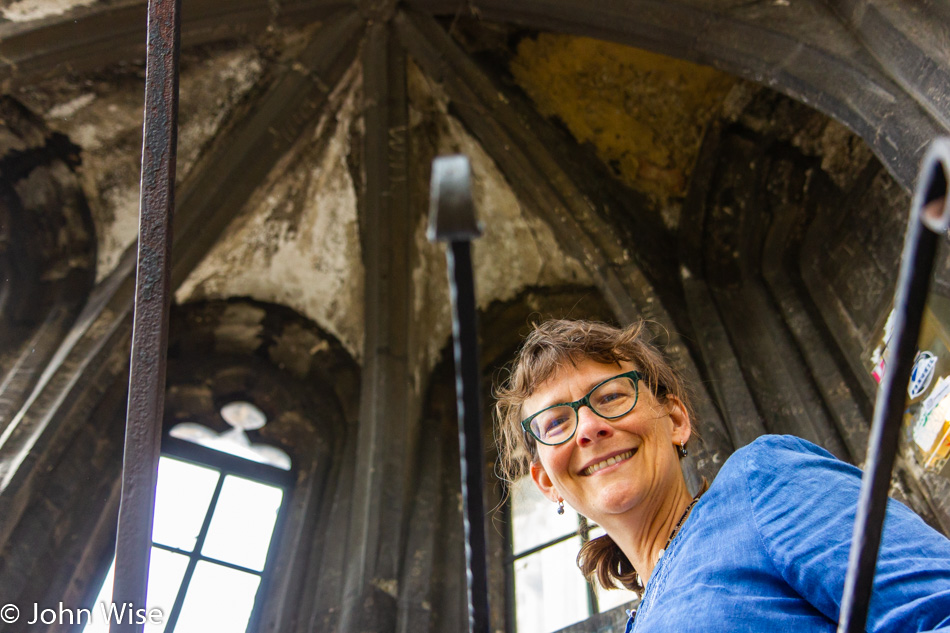
There’s a transfer point while going up and down the tower, so the entire ascent and descent are not always in such intimate quarters.
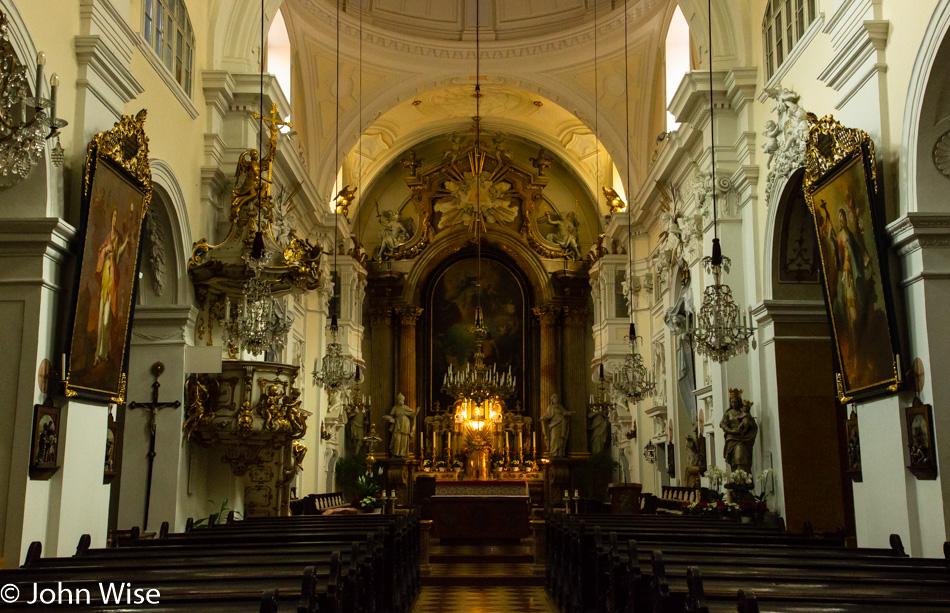
Poked our head into the Church of the Brothers of Mercy.
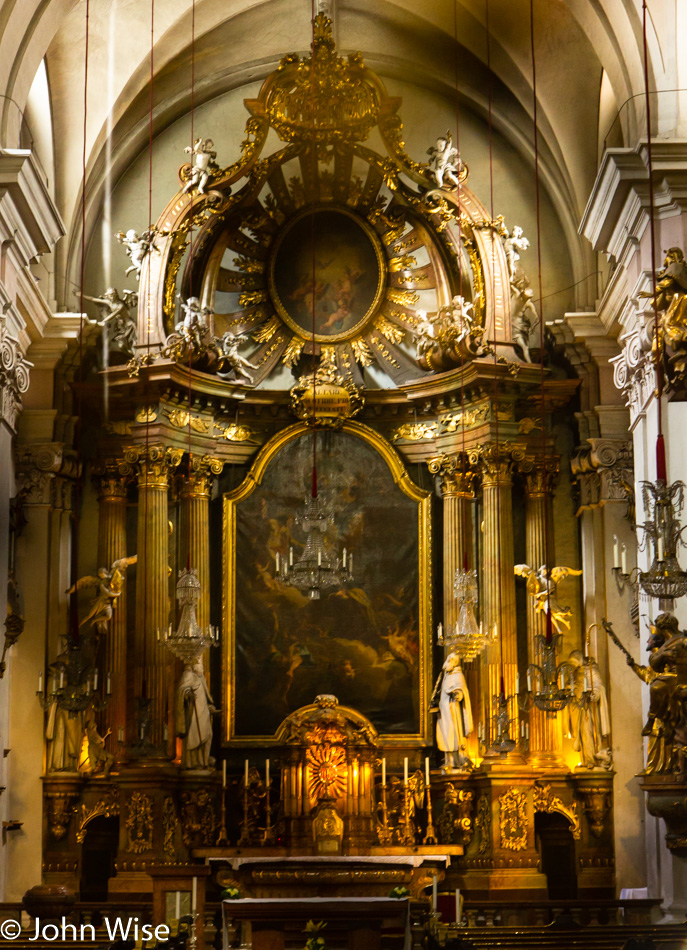
We tried looking into the Carmelite Church, built back in 1623, but couldn’t gain access. So, while the photo is horrible due to being shot through a window, it does give a reference point to another church visited on our visit to Vienna.
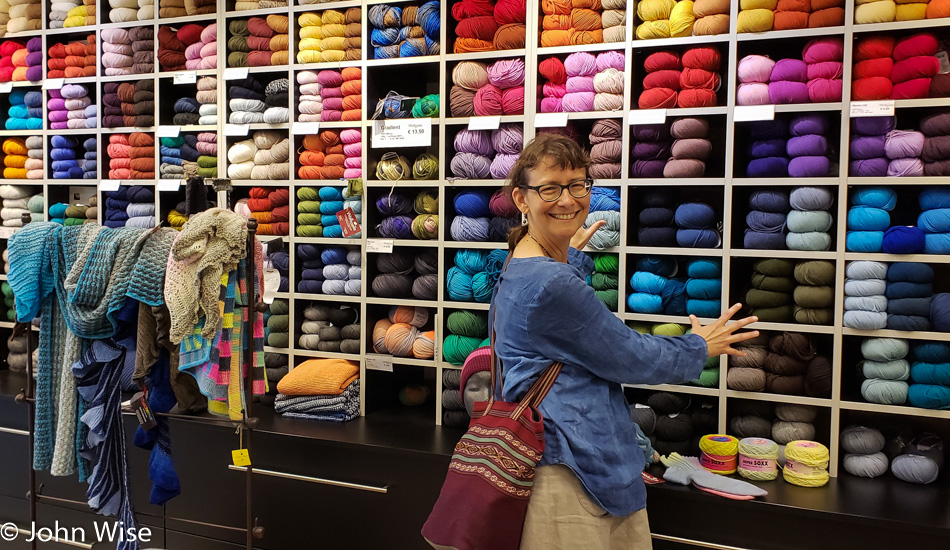
Wollmeile may as well be a church as Caroline gets ready to perform a “Laying on of hands.” The question raised here is not, “Did Caroline buy wool?” but, “How much yarn did Caroline buy?”
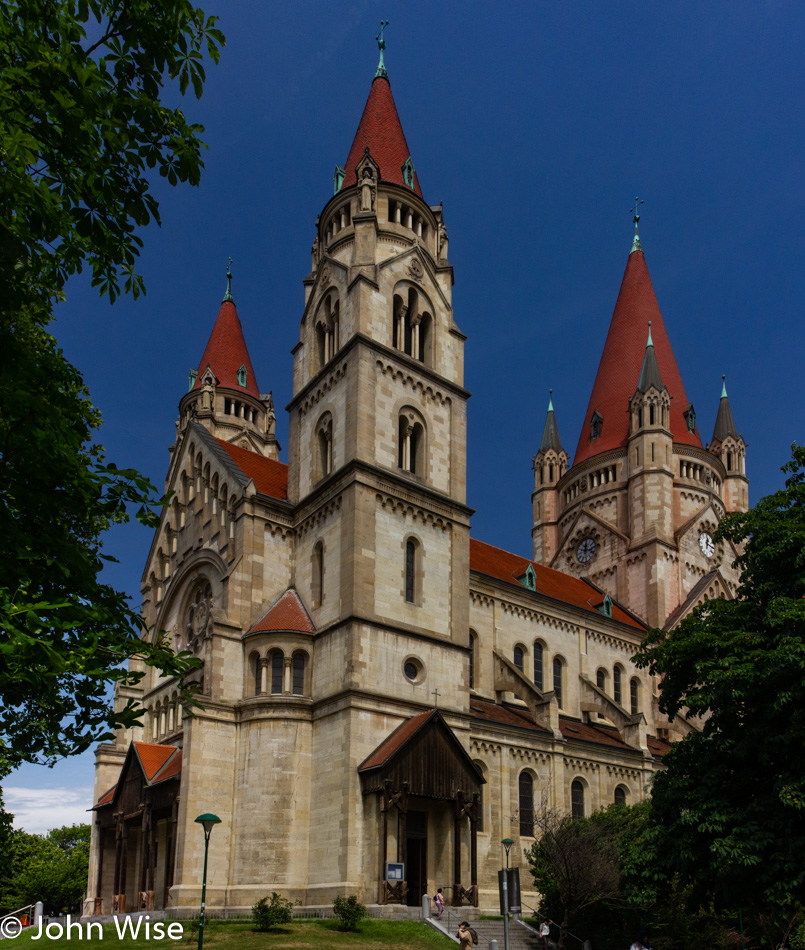
This is the St. Francis of Assisi Church, and was on the way during our trek to see the main channel of the Danube during our stay. Along the way, we also passed the famous Wiener Riesenrad or Vienna Ferris Wheel that has made several appearances in films over the last seventy years, including the movie The Third Man.
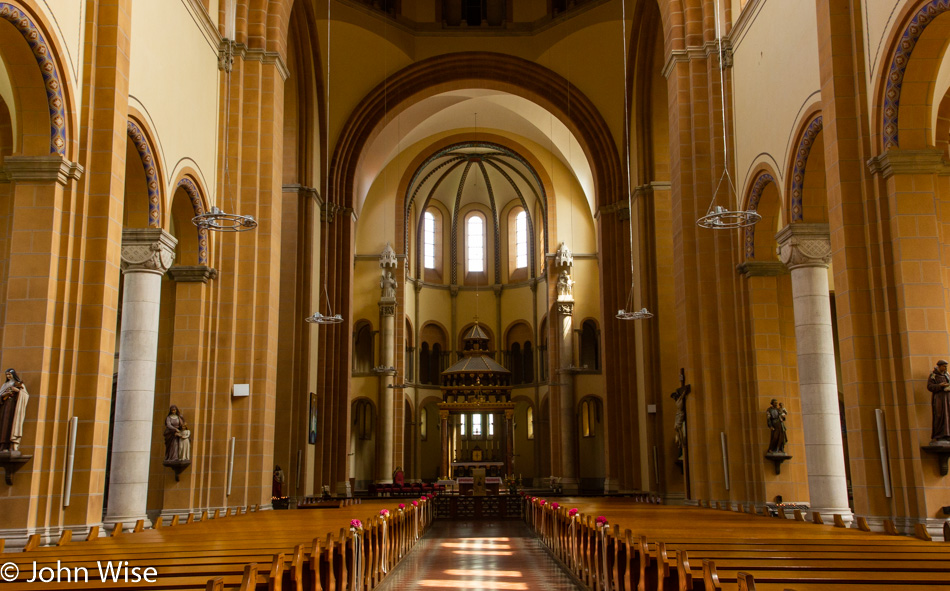
The church is to be found at Mexikoplatz, which got its name following World War II when it was only Mexico that stood with the Soviet Union in protest against the annexation of Austria, better known as the Anschluss, in 1938 by Nazi Germany.
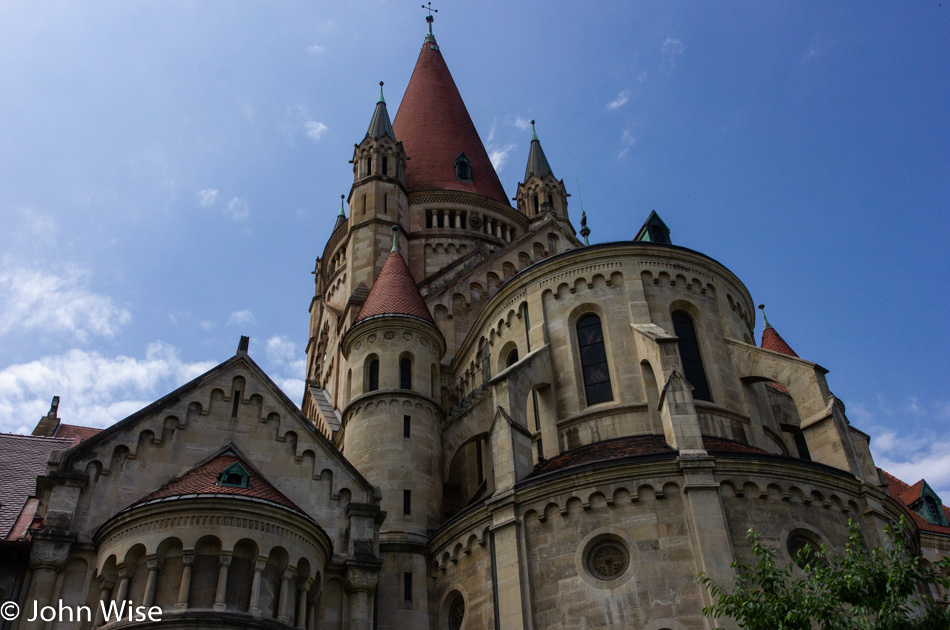
Like a fairy tale building encountering the work of M.C. Escher.
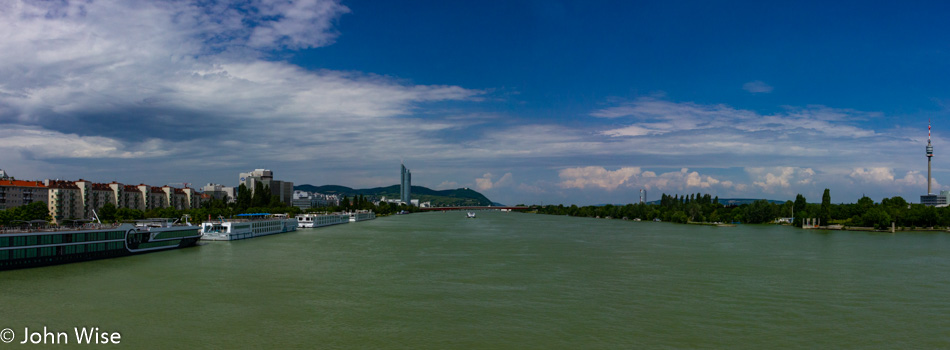
The walk was 3.2 miles or 5.1 km to reach the Danube. My imagination had this famous river running through the heart of Vienna, but considering how it is prone to flood, I see the wisdom of having built the city center well away from this otherwise romantic river. The bridge we are crossing takes us over to the Donauinsel (Danube Island), which is 13 miles long (21 km) and between 230 and 688 feet wide (70 to 210 meters).
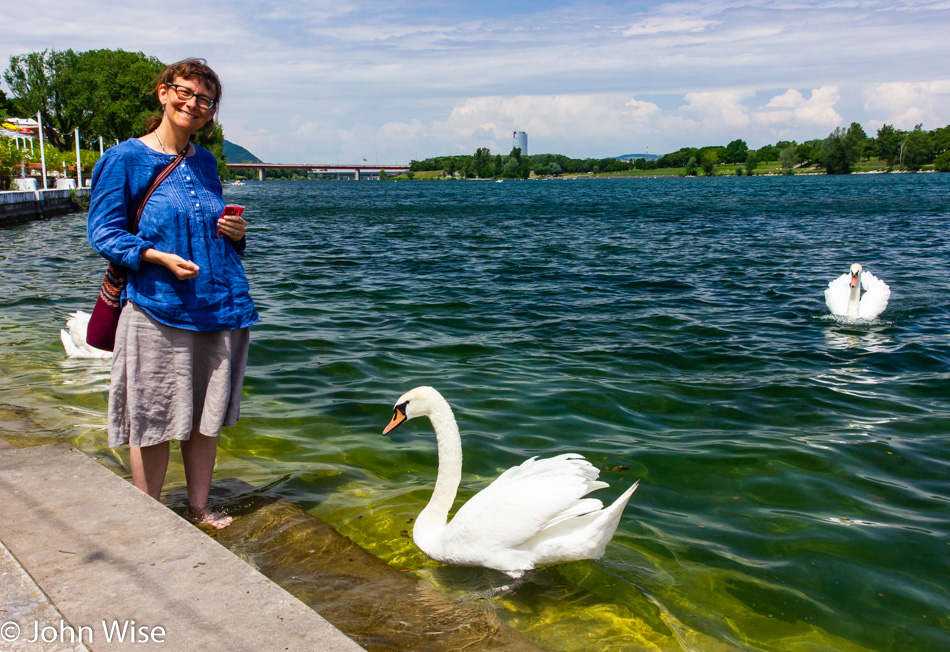
It was established many years ago that if Caroline was encountering a body of water for the first time and the opportunity arose for her to doff her shoes and step into the sometimes icy, at other times tepid waters, she would get busy stepping out of her shoes and socks and dipping her toes in. She’s seen here feeding this beautiful swan some plastic packaging, which killed it about 15 minutes later. Just kidding, as though my tree-hugging environmentalist German woman would do a thing to hurt a creature. She’s sharing the dark rye bread we’ve been carrying with us since Condor Airlines dropped us off in Frankfurt. Our feet needed a break, and as much as we’d have liked to have walked back on some random street north of us, we opted to hop on the subway to dart back into town for lunch and a snack.
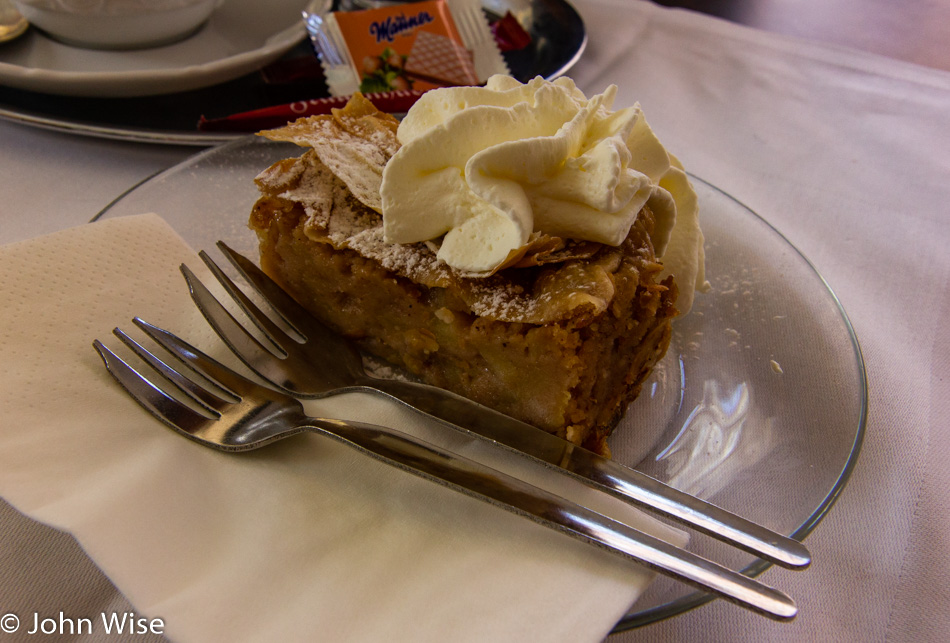
Cafe Frauenhuber on Himmelpfortgasse is not only one of the oldest coffee houses in Vienna, but it also hosted concerts by Mozart and Beethoven during its long history. Lunch for me was a traditional Wiener Schnitzel, while Caroline had sliced blood sausage with roast potatoes that looked an awful lot like eggplant parmesan. Dessert was a yummy apple strudel with cream and a couple of cafe melange (Viennese-style cappuccinos).
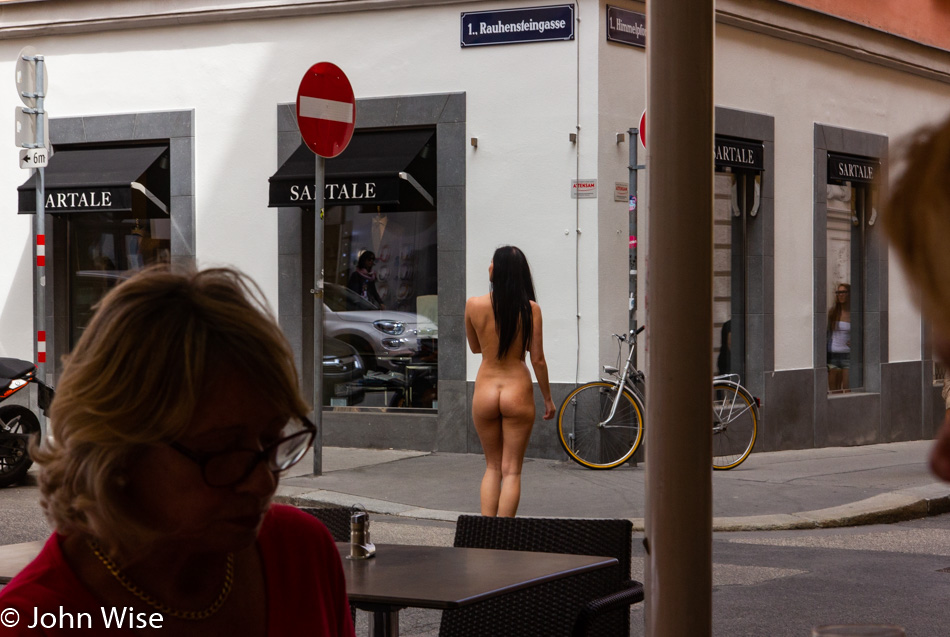
Then, while we’re finishing our coffee, a naked lady walks by. Nobody is yelling at her, and nobody is running over to take her picture. Okay, so I scrambled to grab my camera in time to get a shot of her butt; had I been quicker, I suppose this photo would not have been safe for Facebook. A little ways past our cafe, a crew that had been photographing her gave her a wrap to get dressed in, and off they went.
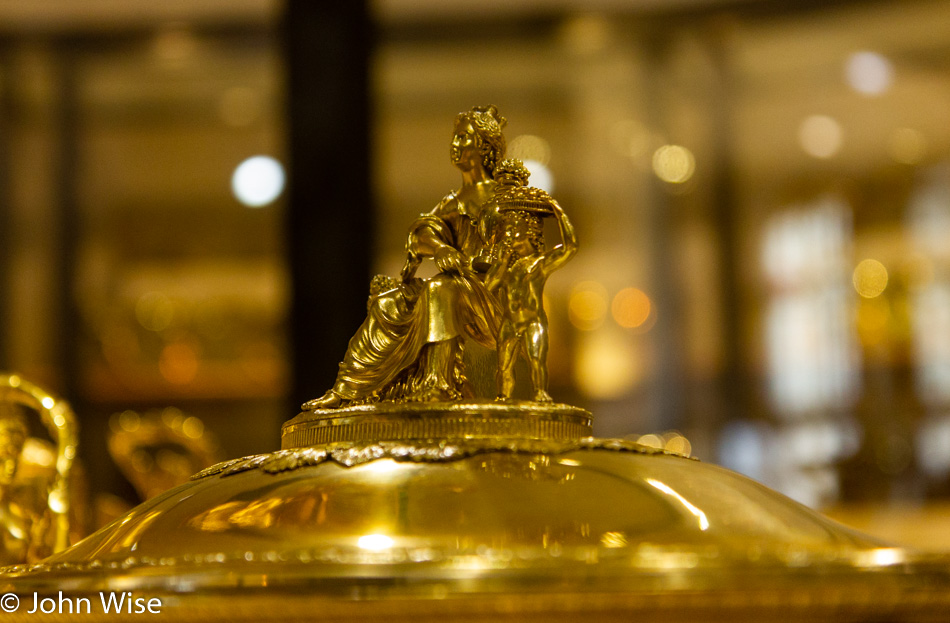
Back to the Hofburg Palace and what might be considered, in retrospect, the first blunder on this trip. Just as we stayed away from the fiaker, we should have stayed away from Hofburg when we saw the crowds. Before you enter, it is made abundantly clear that photography will not be allowed in the Imperial Apartments and the Sisi Museum. However, it is allowed in the Silver Collection.
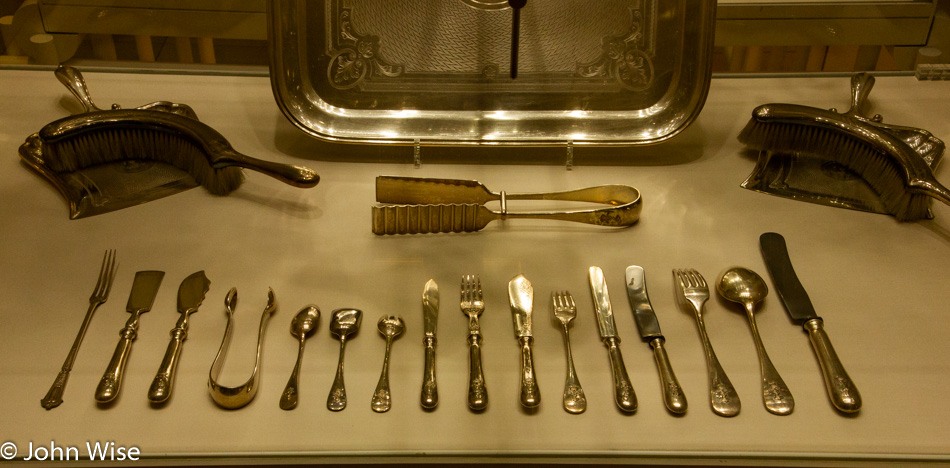
Often, I’ve thought that where photography is forbidden it’s because the museum or state wants to maximize the amount of revenue they can make from their expensive-to-maintain collection and the buildings that house it. In the case of Hofburg, I now believe the reason why no one is allowed to take photos is that the place is so crowded that they slow down as people try to snap images for their memories and their blogs; the pause would grind visitation to a halt. So why is photography allowed here in the Silver Collection?
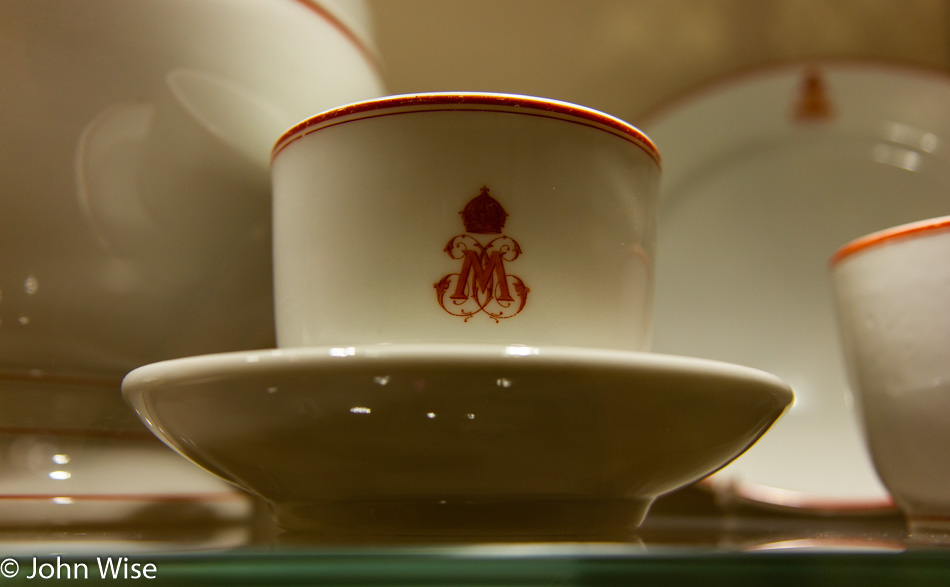
Photography is allowed here because this maze is a gauntlet that visitors race through to get to the apartments and the Sisi Museum. There are thousands of pieces of flatware, silver, gold, and everything else that could accompany a meal both in a palace or on visitation to another Kingdom from across the centuries.

The quantity of handcrafted artwork that was used for piling mashed potatoes into, is extraordinary and makes one wonder if any of it was used on more than one occasion.
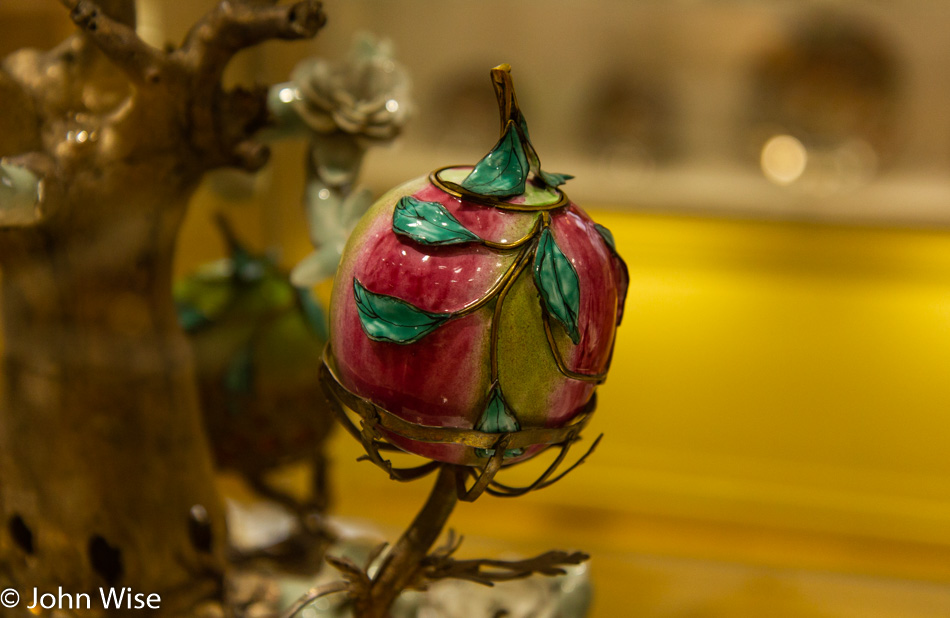
How so much has survived the centuries and invasions by Napoleon, revolutions, plague, and World War II is incredible.
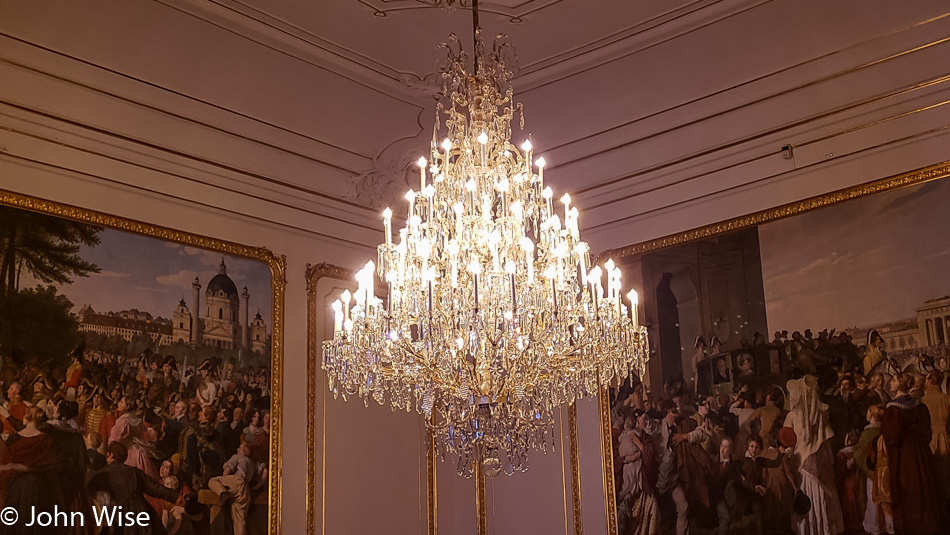
In the cordoned-off Imperial Apartments, it is standing room only and the crowd simply pulses by in a constant push of moving in and quickly out of the hot and humid rooms. Security is an ever-present element, as are the security cameras that are watching us. I took these crappy photos with my phone held down by my belt to not bring attention to myself and the fact that I was trying to get a couple of photos to show the place we were visiting. Before we reached the Imperial Apartments, we had pushed our way through the crowds in the Sisi Museum. Unfortunately, we arrived at the same time as a huge French tour group, and it was impossible to concentrate or see much of anything while the guides were talking, and their captive audience blocked displays and walkways.
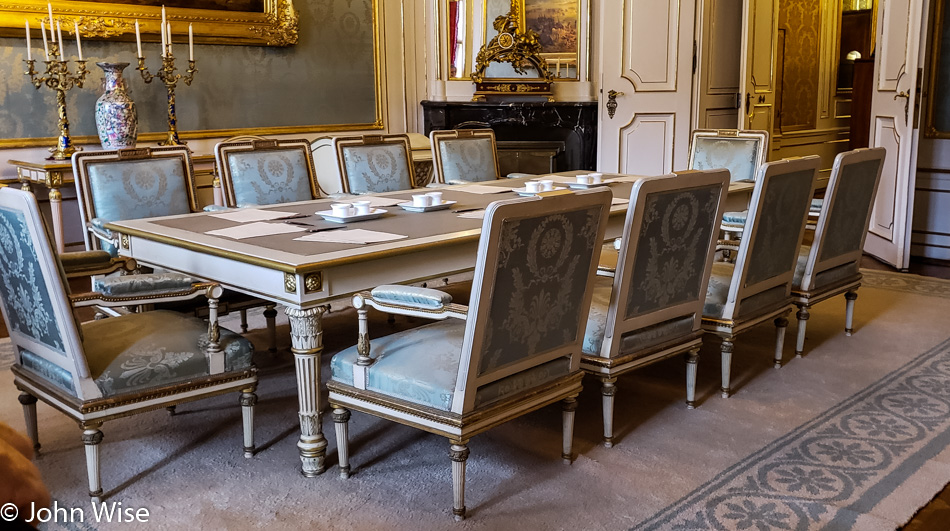
By now, I just really want to get out of the Palace. There has to be a better way of visiting the Hofburg that allows for a quality visit; maybe take a page from the people who operate Hearst Castle over on the California coast and limit the number of guided and timed tours.
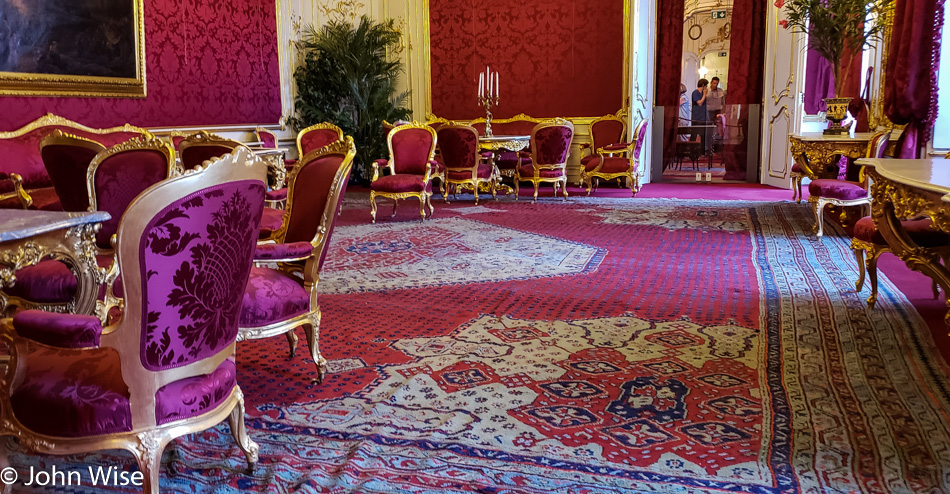
After this, we were brought directly into the gift shop. Was it the naivety of youth that had us believing that gift shops had things that represented a place to such a degree that we wanted to pick up a memento that would remind us of our visit? Today the trinkets and gifts look as if they all came from the same group of factories in China, and every so many hours, the factory retools with designs representing the New York City Metropolitan Museum of Art, followed by the Louvre in Paris, and then the Edwards County Historical Museum and Sod House in Kinsley, Kansas.
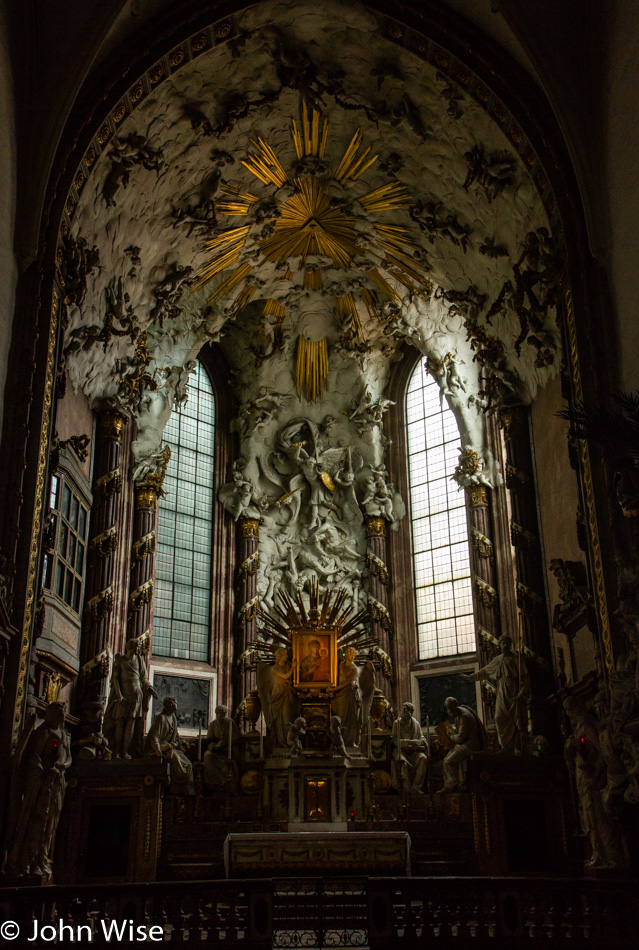
Much more our speed was this visit to St. Michael’s Church, one of the oldest in Vienna. Construction began almost 800 years ago in 1220, and after 575 years of alterations by 1792, it finally reached its current appearance and has remained unchanged since then.

The organ dates to 1714 and is the largest baroque organ in Vienna. According to Wikipedia, it was once played by 17-year-old Joseph Haydn back in 1749, and Mozart’s Requiem was for the first time performed here at a memorial service for the composer on 10 December, 1791.
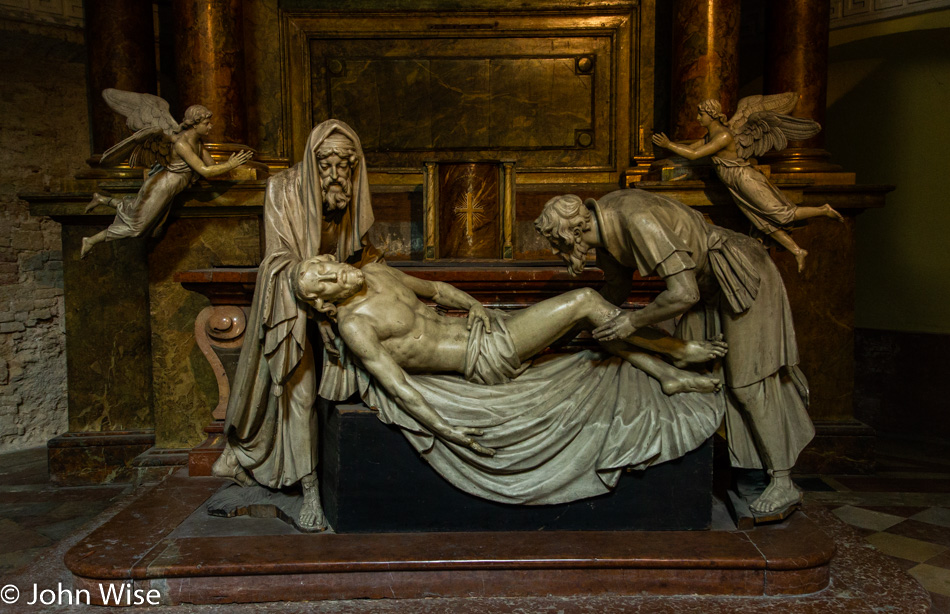
There are a number of tours on offer at St. Michael’s, and if time allows, they all looked interesting but will have to remain unknown to us until we find ourselves on a return visit to Vienna.
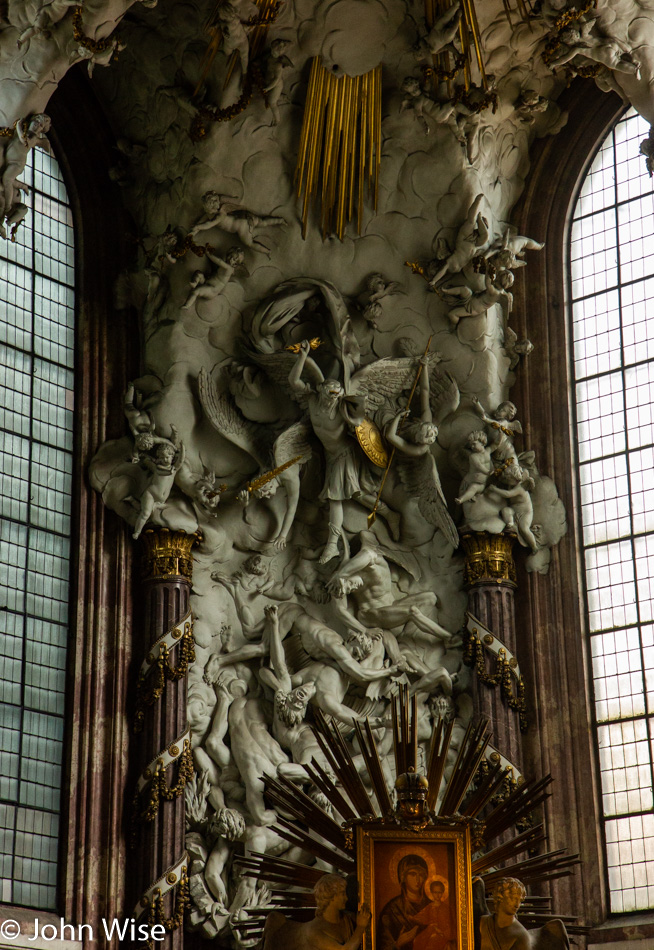
Close-up of the high altar.
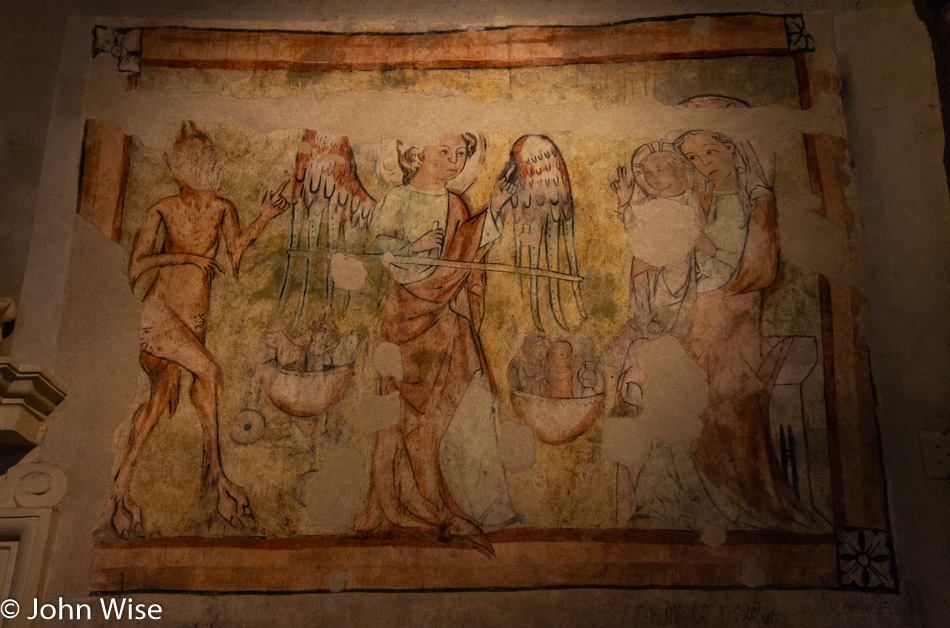
These frescoes were recently uncovered and dated to the early 15th century.
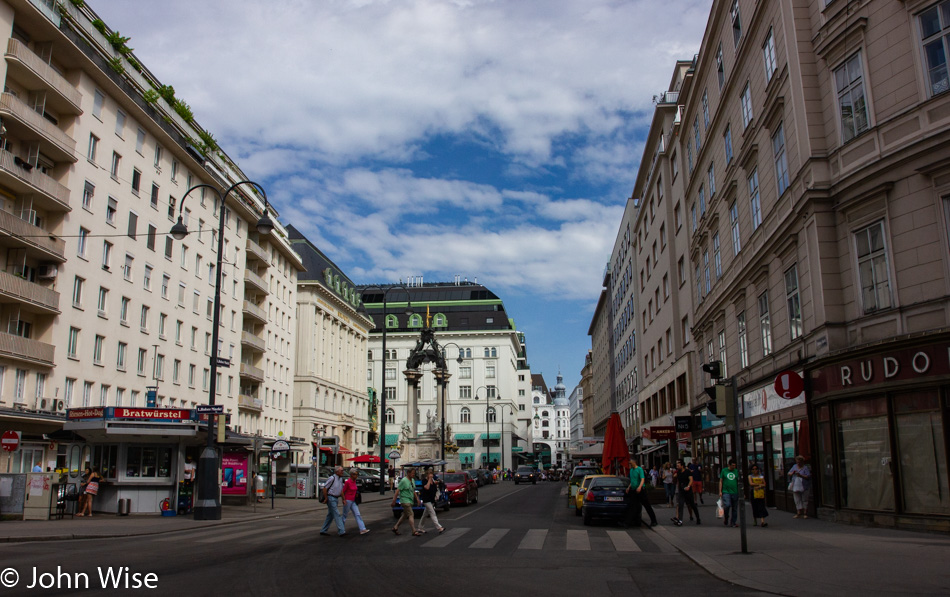
Back on the streets of Vienna, we have a date with a yarn store that must be visited today because tomorrow is Sunday, and it won’t be open.
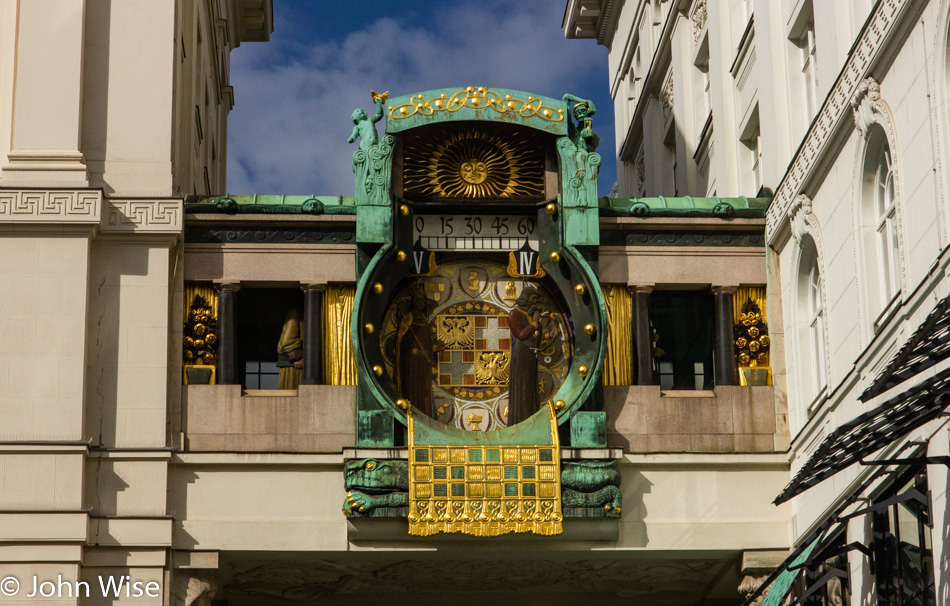
The Ankeruhr Clock is broken. Though we didn’t know that it was broken at the time, we joined the crowd, and so we stood there with everyone else for about 20 minutes until we were certain that nothing was going to happen.
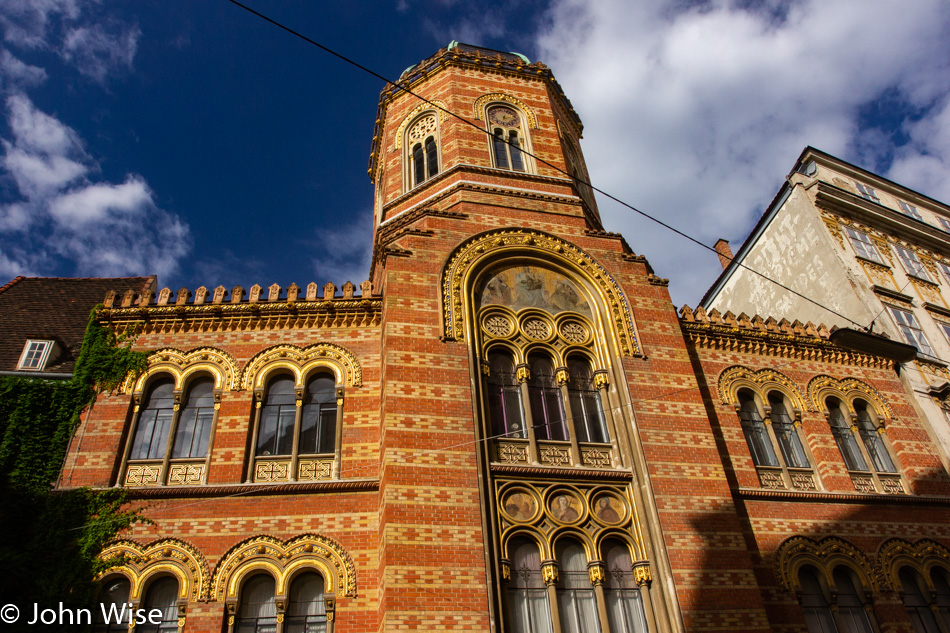
This is the Greek-Oriental Church, and it does not appear to be visitable, which is okay as we have wandered over to this part of town to visit a shop on the ground floor.
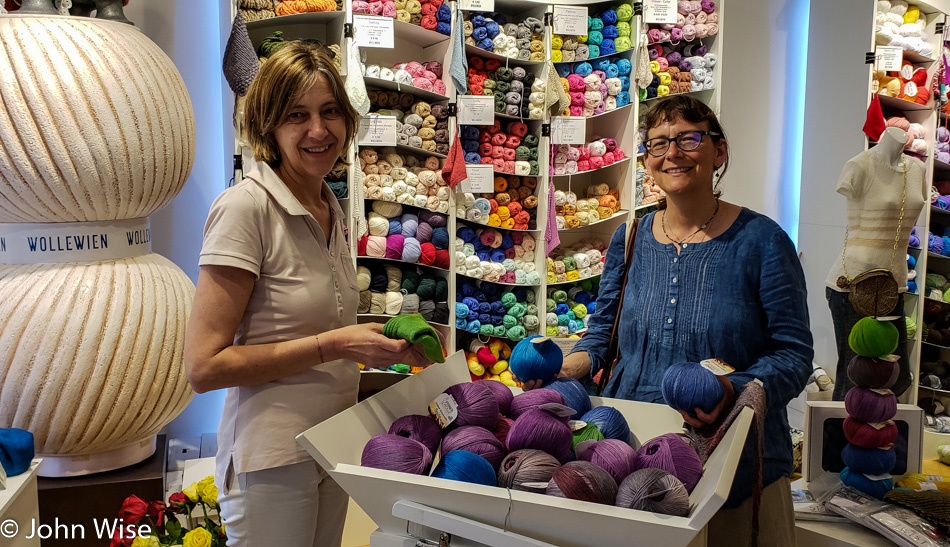
Yep, that’s right, there just may be as many yarn stores as there are churches across Europe. The truth is there are not that many shops, though ask a fiber artist visiting Europe if they wish there were, and I can nearly guarantee you that would be at the top of their list. We are at WolleWien (Wool Vienna) with Gertrud, the owner, who was terrifically helpful and friendly. We even learned a thing or two about Viennese culture from her and received a great recommendation for dinner at a nearby restaurant, Czaak.

Dazed from shopping for yarn twice in one day, Caroline tries to find her way.
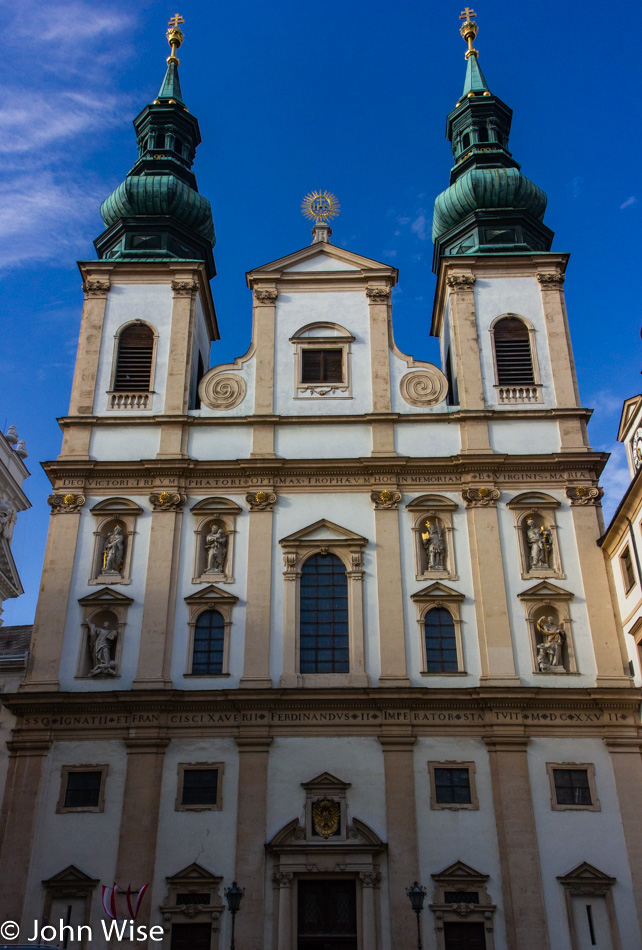
That play on the drinking game never anticipated running into a city like Vienna; there must be a church every two or three blocks in this place. Welcome to the Jesuit Church, which is also known as the University Church. Built between 1623 and 1627, it was consecrated in its last year of construction. Then from 1703 to 1705, the church was remodeled into its current appearance.
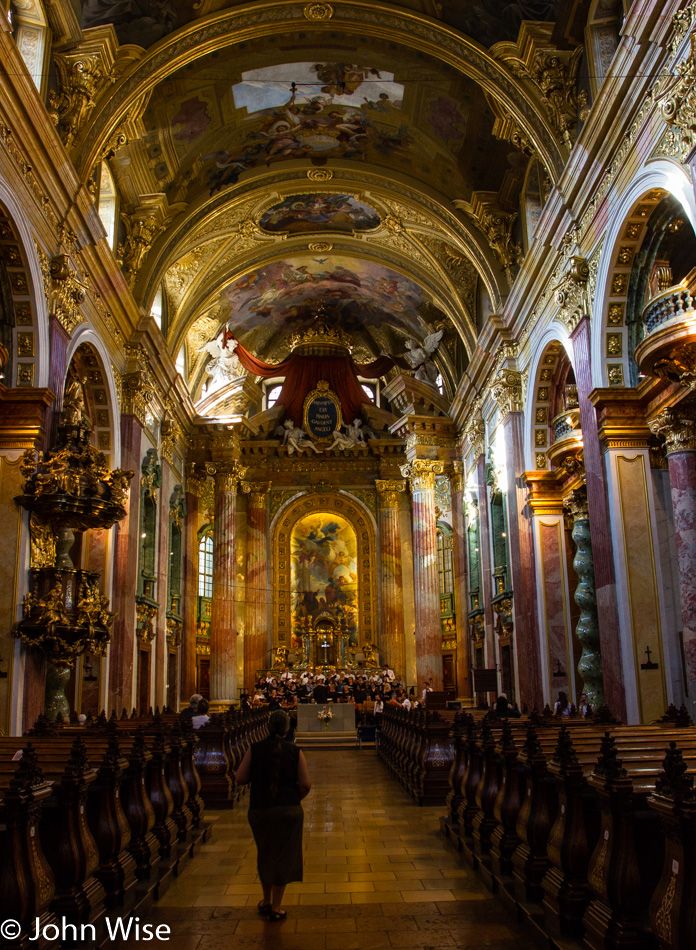
Wow, how do we get so lucky? Another choir at practice works to make this church all the more opulent than it already is.
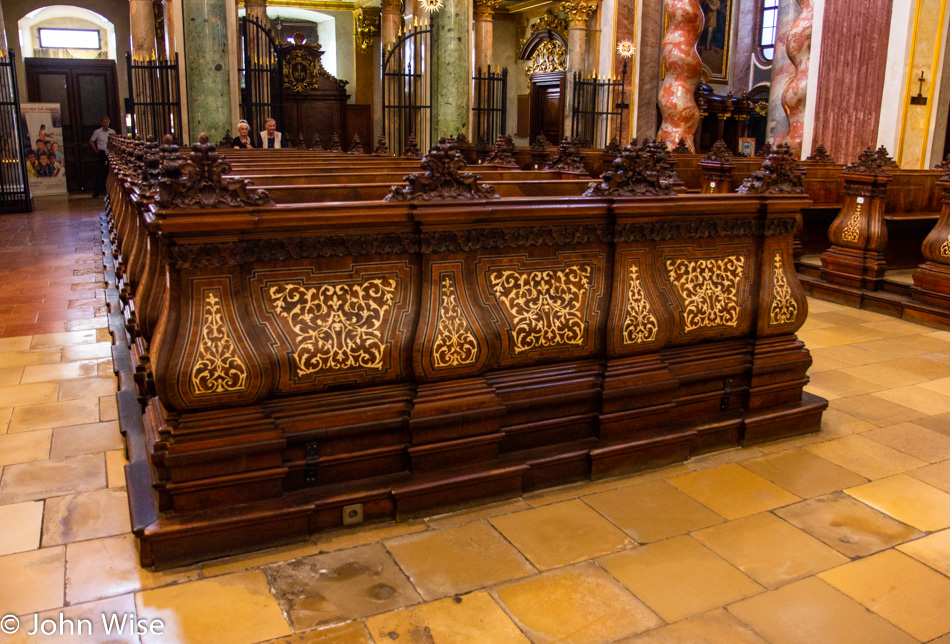
It’s nice to see ornate, heavy pews that grace a church, as I’ve noticed more and more churches with metal and vinyl seating that don’t complement the overall decor and sense of history in the most befitting way.

The Jesuits have a great website that goes into detail about the church that can be found by clicking here.

The organ was just dedicated in 2004.
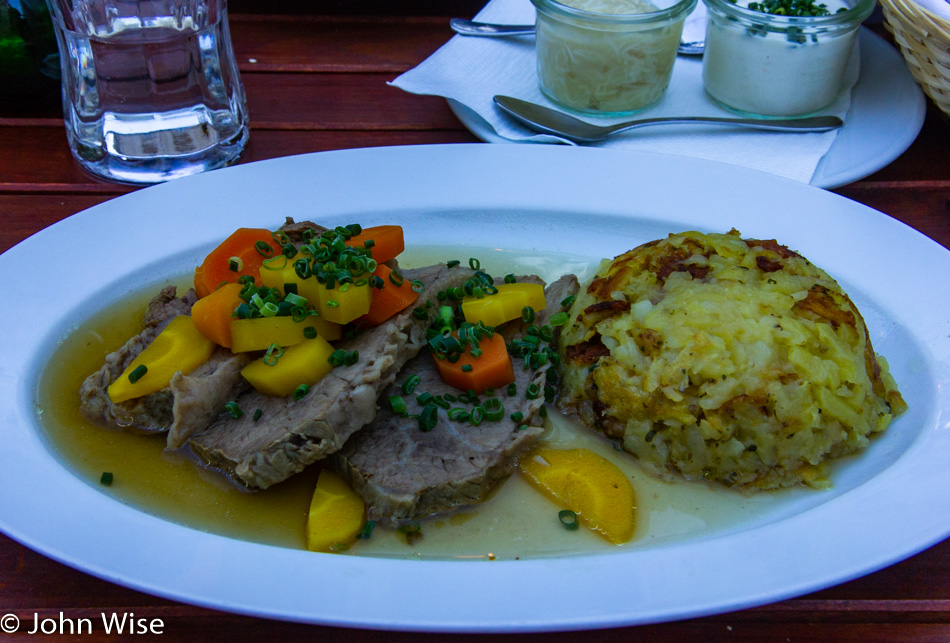
Dinner was again enjoyed on an outdoor patio as the heat was too much to endure indoors. Tonight saw us eating at Beim Czaak serving old-style Viennese food since 1926. This is my first encounter with the classic Viennese dish Tafelspitz, or boiled beef Austrian style.
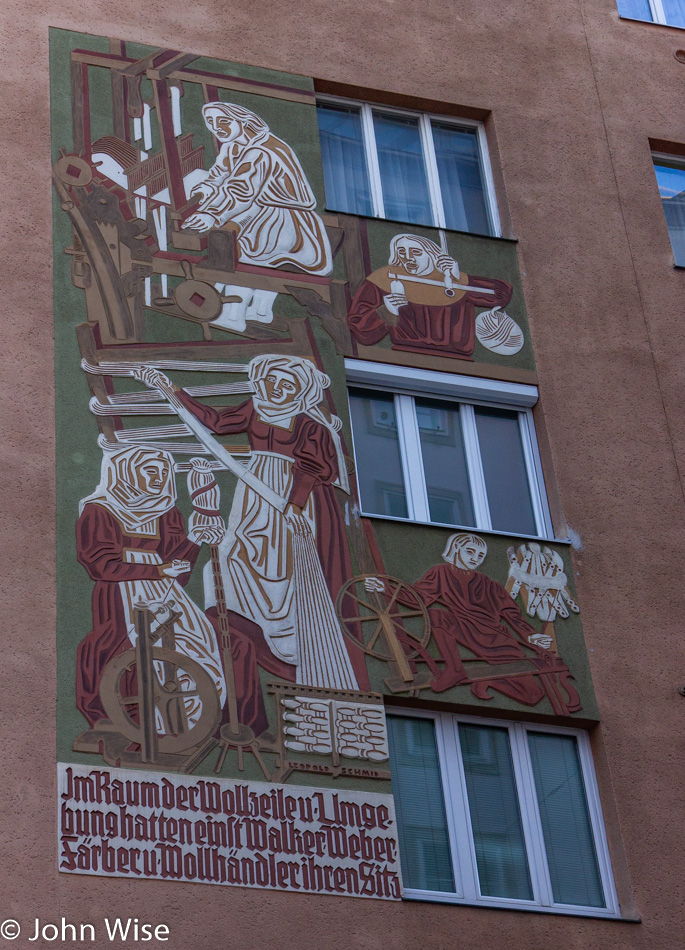
On the way back across the old town, we came across this relief depicting the arts of weaving and spinning fiber into yarn. The “Wollmeile” Street was the heart of the neighborhood that housed many weavers, dyers, fullers, and wool merchants.
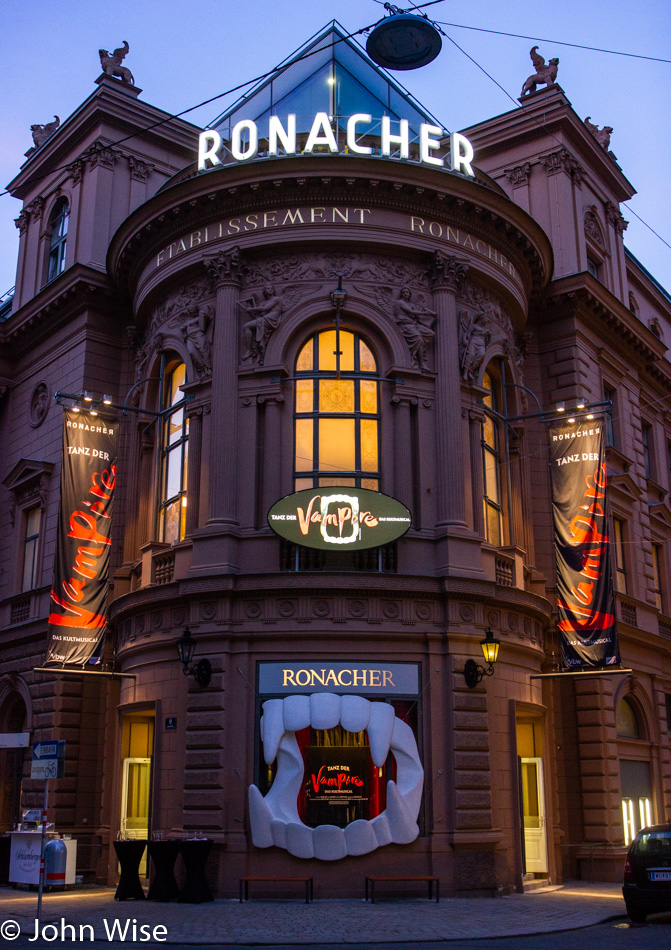
While we won’t have time to take in the theater or a concert, it is abundantly clear that the city of Vienna thrives on an active arts scene.
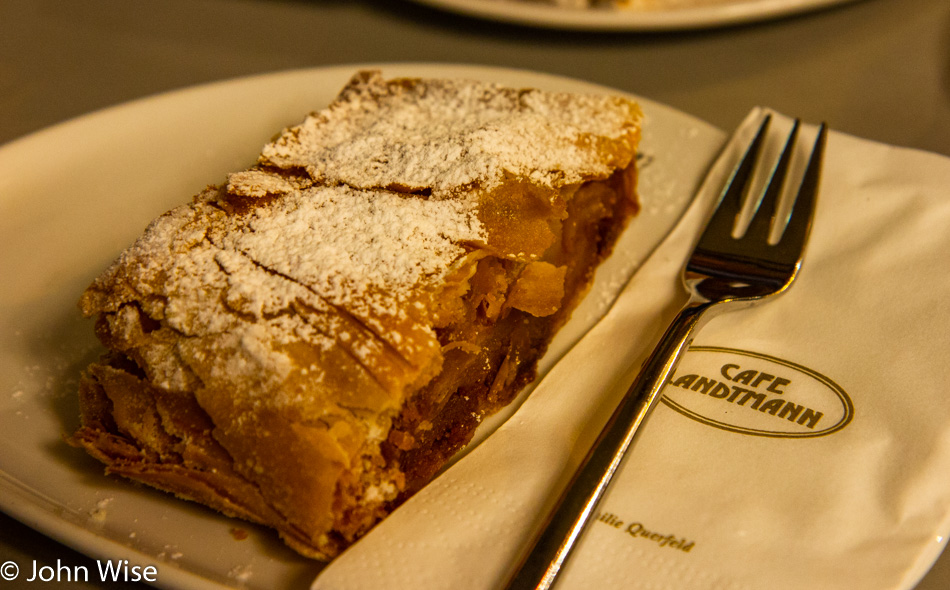
Before calling it quits for the day, we find time for one more dessert along the way. Cafe Landtmann is known for its apple strudel and vanilla sauce, and we were going to have to try it. Since 1873, the cafe has been serving the public, and to demonstrate its popularity, it was packed solid at 10:00 p.m. and is open from 7:30 to midnight seven days a week. As we were enjoying our treat, we could hear the Live Ball event down the street and watch some of it (somewhat delayed) live on TV screens. The musical performance was a modern take on the “Sound of Music,” starring Conchita Wurst as the female lead.
Walking stats: 28,230 steps, 13.2 miles or 21.4 km. Climbed 42 floors.